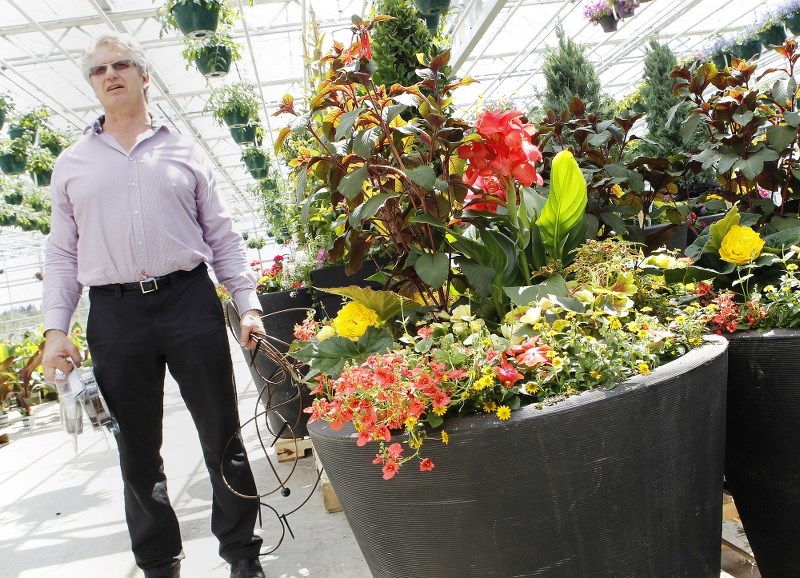Whoever started singing that song about summertime and the living being easy, must not have had a garden.
Gardening requires lots of raking, digging, planting, mowing, weeding, stretching, pruning, bending, watering, bug spraying and weeding. How is that easy?
The trick to easy gardening, say those who love the practice, is easing up on the actual work and, as with most things in life, using the old noggin more than you use the old back. Smarter gardening may mean sacrificing high-maintenance plants and changing them up for easier-to-care-for flowers in pots at the same time as you reseed the lawn with newer grass seed that requires less care.
“Plant fewer containers, but use larger pots. The soil volume doubles for every two inches in diameter as does the moisture holding capacity. The added benefit is that you can add more plants to create unique and interesting combinations,” said Tam Andersen of Prairie Gardens and Greenhouses.
“For less work, start with excellent potting soil,” said retired provincial soil specialist Dr. Ieuan Evans.
Evans is busy with the hybridizing of lilies and has little time to fuss with the multiple pots of geraniums in his yard, but as with many gardeners, he economizes on the soil he uses in his containers.
“The average cost of good potting soil is $20 to $35 per bale. Peat moss is between $5 and $15 per bale. So to conserve costs in my pots I use half potting soil and half peat moss and I use a good fertilizer, because all that peat moss sucks up extra nitrogen,” Evans said.
Peat moss helps to retain moisture in the containers, Evans said, but gardeners using large raised beds that are open at the bottom will find they use less water while experiencing a greater yield in their harvests.
“If the raised bed is open, the carrot roots and so on will go down as much as 10 feet into the subsoil and pull the moisture up. Moisture moves up in the soil so you can go away for two weeks in the summer and leave a raised bed and forget about it and it should be fine,” Evans said.
Evans explained that he buries a pot of tomatoes in the garden so the plants can access the subsoil moisture.
“The pots are warmer than if the tomatoes were planted straight into the ground. Your tomatoes will ripen three weeks earlier if you plant them that way,” he said.
Watering is key whether the plants are in the ground or in a pot.
Jim Hole of Hole’s Greenhouses and Gardens uses a $29 drip system and a $59 timer to automatically water the pots in his own yard.
“It’s so easy because I put the timer on a faucet, and set it to water my tomatoes twice a day,” Hole said.
Of course, bigger pots of flowers require less water and the gardener has to gauge the individual need, but Hole believes he uses up to 50 per cent less water with a drip system.
“It’s also better for the plants because you are watering at the soil line so you have less risk of disease, which sometimes happens when the leaves get too wet,” he said.
While the drip system is a long-term solution for busy gardeners, you can also create a backup water supply for a weekend by freezing a two-litre bottle filled with water, Andersen said.
“Pierce the cap and put the bottle, cap-side down in your pot. The water will drip slowly as it melts so you can head to the lake for the weekend,” she said, adding that if the containers are filled with shade-loving plants, they will also require less water.
“Shade-loving container gardens are easier to look after as they don’t wilt and dry so quickly as those on host sunny decks. Non-stop begonias, impatiens, calceolaria and lamiastrum look wonderful together,” Andersen said.
For easier lawn maintenance, Hole recommends using Manderley seed.
“I poked holes in my lawn and sprinkled Manderley seed, which is Kentucky bluegrass and rye grass. You have to treat it like any other seed for the first 14 days, until it gets established, but it will eventually take over other grass in the garden and will require 50 per cent less water,” Hole said, adding that he prefers the look of grass to other ground covers.
“Grass is a natural air-conditioner and there is a cooling effect from it. If you put down rock, it doesn’t add anything to the soil and beneath that rock there is a continual loss of organic matter. Grass looks better,” he said.
Keeping the edges of beds tidy with professional flowerbed edgers placed at mow-over heights, will eliminate the need for a string trimmer, Andersen said, adding that by eliminating thirsty high-maintenance shrubs, the gardener can save a lot of time and energy.
“The use of solid performers like yellow gem potentilla planted in repeating multiples of threes will create a clean and simple strategy for a showy front-yard bed. Sacrifice high maintenance shrubs and trees in favour of planting perennial grasses like blue fescue, blue oat grass, Carl Forester or Overdam feather reed grass that have interesting foliage colours in mounds and remain neat and tidy all season,” Andersen said.
Finally, become more eco-friendly in your garden by adding organic compost, shredded leaves or bark mulch heaped at least three inches deep over exposed soil in vegetable, perennial or shrub beds.
“The mulch will conserve moisture and eliminate weeds,” Andersen said.




